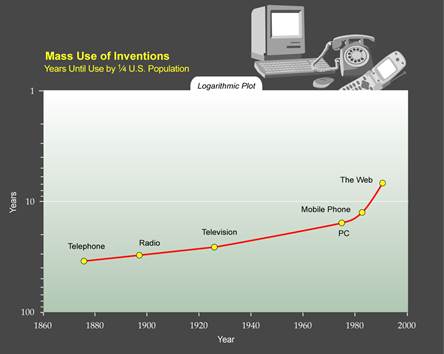Hi folks,
It may be just me, but I see the term futurist tossed around a lot these days. I’m pretty sure the blame can placed on the Iron Man movies:

I mean, who doesn’t want to be an uber-genius billionaire philanthropist playboy superhero?
But for as made-up as the term sounds, it’s real and used to describe a person who tries to predict the future based on trends in the present. Yes, this is a legitimate profession and people get paid for this. No, they typically don’t use tarot cards and crystal balls.

Either way, some of these futurists subscribe to the theory of accelerating change. Mostly it describes a continual increase in the rate of technological change, but it can also describe accompanying societal change as well. And in some ways we’ve seen this during our lifetimes:

When it comes to technology, change arrives quickly.
So if you work in technology, it’s safe to assume you need to be adept at reacting to change. Duh, right? But what happens when a technologist – especially one from the even more quickly changing security field – tries to push change upon a population who likes the status quo? Or at least doesn’t like your change? Well, there’s usually pushback – attempts to slow/stall/stop the change.
There are innumerable examples of this how this pushback manifests, but a great one is from outside the technology field.
In the 1990s, President Clinton was taking a stab a health care reform. He failed for many reasons, but one of the factors was a series of very successful attack ads that fomented doubt about the proposal. The famous Harry and Louise ads were gloriously simple – a married couple sitting around complaining about the proposed changes, ending the ad with Louise wistfully wondering aloud “There’s got to be a better way.”
This is perhaps the laziest – but also perhaps the most effective – means of refuting a proposal. The objector doesn’t have to come up with a better idea – they just have to implant suspicion that a better idea exists. And in the intersection of an ever-changing field like infosec and the not-bleeding-edge government, it’s likely true that a “better way” exists as capabilities evolve and solutions emerge. But that shouldn’t get in our way or progress. Again, listen to Skeletor:

How can you combat this insidious lazy man’s effort to avoid change? One way is by formulating counterarguments. Counterarguments don’t directly confront the “better way” opposition, but they strengthen your proposal in multiple ways:
- They make you consider the ways in which your argument can be improved (and hopefully you then make those improvements)
- They make you anticipate the ways in which your argument will be opposed, allowing you to develop counter-strategies
- When you share your counterarguments, you show your audience that you’re considering multiple angles, increasing the faith in your conclusions
Much of what we do in strategic security is submit proposals to an audience for consideration. And because we’re human and thereby convinced of the righteousness of our own proposals, we often forget to consider the likely opposition. This reduces our rate of getting proposals/plans/etc passed. The more frequently we develop counterarguments for our proposals before sending them out the door, the better our batting average becomes.
So there you go. From Iron Man, to accelerating change, to President Clinton, to counterarguments. How you like me now?

I’ll take it.
Rex